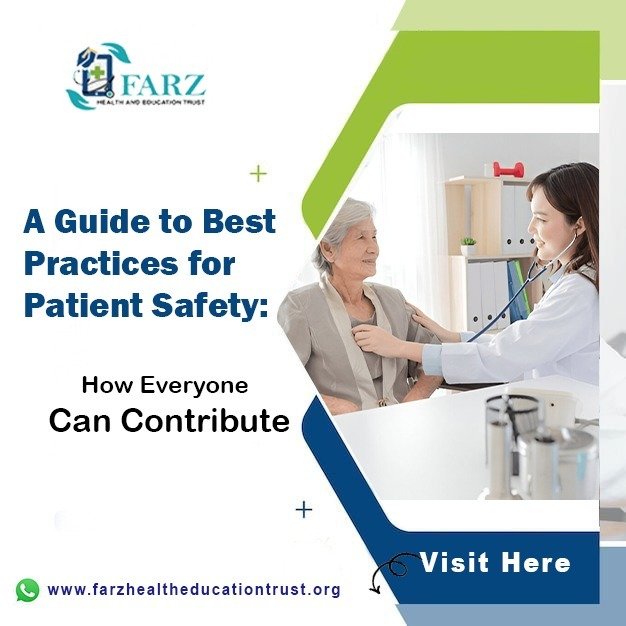
Patient safety is a critical aspect of healthcare that often gets overshadowed by other priorities. However, ensuring that patients receive safe care is essential to improving outcomes, reducing harm, and building trust within the healthcare system. This guide outlines best practices for patient safety and explains how everyone, from healthcare providers to patients themselves, can contribute to a safer environment.
Why Patient Safety Matters
Patient safety is not just a matter of avoiding errors; it’s about creating a culture where risks are minimized, and patients are protected at every stage of care. Poor patient safety practices can lead to medical errors, infections, and even fatalities. By adhering to best practices, healthcare systems can significantly reduce these risks, creating an environment where patients receive the highest quality of care.
Key Principles of Patient Safety
- Prevention of Harm: The core goal of patient safety is to prevent any form of harm that could come from healthcare services. This can be achieved through careful planning, good communication, and effective risk management.
- Error Reporting and Transparency: A system that encourages healthcare providers to report errors without fear of punishment ensures that safety measures can be improved continuously.
- Continuous Education: Health professionals must stay up-to-date on the latest safety guidelines, treatment protocols, and technological innovations to ensure the highest standards of care.
- Patient-Cantered Care: Safety involves not only healthcare providers but also patients. Ensuring patients have the information and tools they need to make informed decisions is essential to preventing harm.
Best Practices for Patient Safety
1. Clear Communication among Healthcare Providers
Effective communication among healthcare professionals is vital to patient safety. Miscommunication can lead to errors in diagnosis, treatment, and medication. Best practices include:
- Hand-off Protocols: Ensure a clear, standardized process for transferring patient information between healthcare providers at every stage of care.
- Team Collaboration: Encourage multidisciplinary teams to work together, share insights, and make decisions based on collective expertise.
- Documentation: Accurate and thorough documentation of patient history, treatment plans, and medical decisions can prevent mistakes and improve continuity of care.
2. Medication Safety
Medications are one of the most common causes of patient harm. Best practices for ensuring medication safety include:
- Double-Check Systems: Always verify the patient’s identity, dosage, and medication before administering.
- Patient Education: Educate patients about their medications, including possible side effects, dosing schedules, and the importance of adherence.
- Use of Technology: Utilize electronic health records (EHRs) and medication management software to track prescriptions and avoid errors.
Essential Tips for Protecting Yourself and Others on World AIDS Day
3. Infection Control
Healthcare-associated infections (HAIs) are a significant risk to patient safety. Implementing stringent infection control practices is essential. These include:
- Hand Hygiene: Proper hand washing by healthcare workers, patients, and visitors is one of the simplest and most effective ways to prevent infections.
- Sterilization and Disinfection: Use proper sterilization procedures for medical instruments and ensure that environments are kept clean.
- Vaccination for Healthcare Workers: Ensure healthcare workers are vaccinated against preventable diseases to protect themselves and their patients.
Top 5 Dietary Changes to Relieve Constipation: A Comprehensive Guide
4. Patient Involvement in Care
Patients are essential members of the healthcare team and should be actively involved in their care. This can improve outcomes and prevent mistakes. Best practices include:
- Active Listening: Healthcare providers should actively listen to patients, ensuring they understand their concerns and symptoms.
- Informed Consent: Ensure patients understand the risks, benefits, and alternatives of any proposed treatment.
- Encourage Questions: Allow patients to ask questions about their diagnosis, treatment options, and care plan.
5. Creating a Culture of Safety
Safety is everyone’s responsibility. Healthcare organizations should foster a culture where safety is a top priority. Best practices include:
- Leadership Commitment: Healthcare leaders must model and support patient safety initiatives.
- Regular Training: Regularly train staff on safety protocols, emergency response procedures, and new safety guidelines.
- Feedback Loops: Use patient feedback and staff suggestions to improve safety protocols and practices.
How Patients Can Contribute to Their Own Safety
Patients can play a vital role in their safety, especially when they are informed and actively involved in their care. Here are some ways patients can contribute:
- Be an Advocate for Your Own Health: Ask questions and seek clarification on treatments, medications, and procedures.
- Keep an Updated Medical Record: Ensure your healthcare provider has accurate, updated information about your health history, allergies, and medications.
- Follow Instructions Carefully: Adhere to prescribed treatment plans, medication schedules, and lifestyle recommendations to avoid complications.
- Speak Up: If something feels wrong or confusing, don’t hesitate to ask your healthcare provider to explain it again.
The Role of Healthcare Organizations in Patient Safety
Healthcare organizations are responsible for creating an environment that prioritizes patient safety. They can implement strategies such as:
- Adopting Safety Standards: Follow national and international guidelines for patient safety and ensure compliance at all levels.
- Encouraging Error Reporting: Provide anonymous ways for staff to report errors, near misses, and safety concerns to continuously improve care.
- Investing in Technology: Use advanced technologies like electronic health records (EHR) and patient safety monitoring systems to improve care delivery.
Conclusion
Patient safety is a collective responsibility. By adhering to best practices and fostering a culture of collaboration and transparency, we can ensure that patients receive the safest possible care. Healthcare providers, patients, and organizations must work together to prevent harm, improve outcomes, and promote a safer healthcare environment. Let’s make patient safety a priority—every day, in every way.
